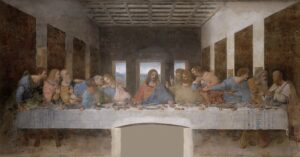By John H. Niemelä
For we are His workmanship, created in Christ Jesus for good works, which God prepared beforehand that we should walk in them (Eph 2:10).
Perseverance theology has treated this verse as a prooftext for Calvin’s infamous 1547 dictum: “It is therefore faith alone which justifies [cf. Eph 2:8-9], and yet the faith which justifies is not alone [per the Calvinist twisting of Eph 2:10].”1
Calvinists imagine that Eph 2:10 teaches that all true believers will persevere in good works. They reason as follows:
- Every believer is God’s workmanship.
- God’s workmanship involves foreordaining certain works for each believer.
- Every true believer necessarily will perform the works God foreordained.
Steven J. Cole’s treatment of Eph 2:10 is typical: “Thus, genuine salvation involves God creating something new [God’s creative workmanship]. It inevitably results in a life of good works because God ordained such works before He saved us.”2 Notice the words “a life of good works.” Calvinists assume that in Eph 2:10, Paul was teaching perseverance in good works until death (the P in TULIP).
The apostle Paul would shudder at such a gross twisting of his words.
It is noteworthy that verse 10 follows immediately after Eph 2:8-9: “For by grace you have been saved through faith, and that3 not of yourselves; it is the gift of God, not of works, lest anyone should boast.”
Notice the pronouns in verses 8-9. “You” is second person plural. To distinguish singular from plural, I will call the plural y’all and the singular you.
Why did Paul switch from y’all in verses 8-9 to we in verse 10? Surely, he had a reason. Couldn’t he have written, “For y’all are Christ’s workmanship created in Christ Jesus for good works, which God prepared beforehand that y’all should walk in them”? In fact, if he had wished to focus on individuals, he could have used second-person singular pronouns in verse 10: “For you are Christ’s workmanship created in Christ Jesus for good works, which God prepared beforehand that you should walk in them.”
Ephesians 2:10 contains a subject (we),4 a linking verb (are), and a predicate nominative (workmanship, better translated as masterpiece). The subject (we) is plural, but the predicate nominative (poiēma =masterpiece) is singular.
Such constructions convey a corporate, not individual, emphasis. The following passages exemplify the corporate focus of singular predicate nominatives with plural subjects:
Romans 12:5. We, being many, are one body in Christ.
1 Corinthians 12:27. Y’all are the body of Christ.
1 Corinthians 3:9. Y’all are God’s field; y’all are God’s building.
Unfortunately, virtually everyone5 has missed the corporate focus of Eph 2:10, a passage within a corporate context.6 Many English translations hide Paul’s plural subject and singular predicate nominative with the rendering workmanship. That word lacks a distinct plural form, as the following sentences show:
The Mona Lisa is da Vinci’s workmanship.
The Last Supper is da Vinci’s workmanship.
The Mona Lisa and the Last Supper are da Vinci’s workmanship.
By contrast, masterpiece has distinct singular and plural forms:
The Mona Lisa is da Vinci’s masterpiece.
The Last Supper is da Vinci’s masterpiece.
The Mona Lisa and the Last Supper are da Vinci’s masterpieces.


Paul calls the universal church the Lord’s masterpiece.7 Christ’s body, the church, was created to accomplish certain good works that God prepared beforehand. How did He prepare beforehand for those works to be accomplished? He gave the New Testament—the very book that tells the church what pleases Him. Though the universal church has had many failings in almost 2,000 years of existence, God certainly will affirm that it has accomplished those good works of which Eph 2:10 speaks.
Crucially, Paul repeatedly uses the first person plural, we, in verses following Eph 2:10. After reminding the readers (y’all) in verses 11-13 of their former status, Paul then refers to our peace (v 14), to making both [Jews and Gentiles] one [the church] (v 14), to having abolished the enmity between Jews and Gentiles (v 15), to creating one new man from the two [Jews and Gentiles] (v 15), to reconciling them both in one body [the church] (v 16), and to y’all [Gentiles] who were far off and to those [Jews] who were near (v 17), and to we both [Jews and Gentiles] (v 18).
The glorious truth in Eph 2:10 is that the church—in which Jews and Gentiles are united into the one body of Christ—is God’s masterpiece. Perseverance theology misconstrues and waters down these words into an excuse for fruit inspection and the abolishing of assurance of everlasting life. It would horrify Paul.
Samuel John Stone, a nineteenth-century song writer, captured from Eph 2:10 what has eluded theologians and commentators. His hymn, The Church’s One Foundation, perceives that the church is the Lord’s created masterpiece.
The church’s one foundation
is Jesus Christ, our Lord;
we are a new creation…
___________________
John is president of Message of Life Ministries. He and Diane recently moved to rural Knox County, TN, to be near their son, George. John is working diligently on his forthcoming commentary on John’s Gospel.
1 John Calvin, Antidote to the Council of Trent (1547), https://www.monergism.com/thethreshold/sdg/calvin_trentantidote.html. Accessed August 21, 2021.
2 Steven J. Cole, “Lesson 15: Salvation and Good Works (Ephesians 2:10),” https://bible.org/seriespage/lesson-15-salvation-andgood-works-ephesians-210. Accessed August 21, 2021.
3 Greek grammar does not allow the word that (contrary to many Calvinists) to mean “that faith.” Instead, that points to “by grace salvation.” See John H. Niemelä, “Is Faith Even a Tiny Part of God’s Gift (Ephesians 2:8-9)?” JOTGES 33 (Autumn 2020): 53-66.
4 The first plural verb esmen (“we are”) has hēmeis (“we”) as the understood subject. When used of believers, the word “we” in Ephesians often refers to the church.
5 My background reading on Ephesians is extensive, since I taught it in seminary Greek courses about forty times. However, the literature is silent on this issue—apart from publications by a former student of mine and by myself: 1. Timothy R. Nichols, “Reverse-Engineered Outlining: A Method for Epistolary Exegesis,” CTSJ 7 (April 2001): 38-39; 2. John H. Niemelä, “If Anyone’s Work Is Burned: Scrutinizing Proof-Texts,” CTSJ 8 (January 2002): 31-32; 3. Timothy R. Nichols, “Dead Man’s Faith: Spiritual Death, Faith, and Regeneration in Ephesians 2:1-10,” (Th.M. thesis: Chafer Theological Seminary, 2004; and 4. Timothy R. Nichols, Dead Man’s Faith: Spiritual Death, Faith, and Regeneration in Ephesians 2:1-10, (N.p.: Headwaters Christian Resources, 2016), 38-39.
6 Ephesians 2 is all about how God joins Jewish and Gentile believers into Christ’s body, the church.
7 If Paul had wished to refer to individuals, he could have said, “Each one of us is His masterpiece.” Instead, he argues here that the church is His masterpiece.

